






SMM: from the first half of the sales data, the proportion of joint venture brands and independent brands still showed a significant decline, as the main driving force of the weak market situation-the upward trend of the luxury car market is even more commendable, while deconstructing the specific sales data of luxury cars in the first half of the year can further reveal the trend in this market segment, as well as clues of new changes in the second half of the year.
Overall trend of luxury brands: outperform the market and rise in decline
In terms of overall sales, luxury brands sold a total of 1480250 vehicles in the first half of 2020, down 3.94% from 1540935 in the same period last year. According to the overall sales base of 3111168 luxury brands in 2019, if it falls by 3.94% year-on-year, sales will be reduced by more than 120000, which poses a challenge for luxury brands that are not dominant in absolute numbers.
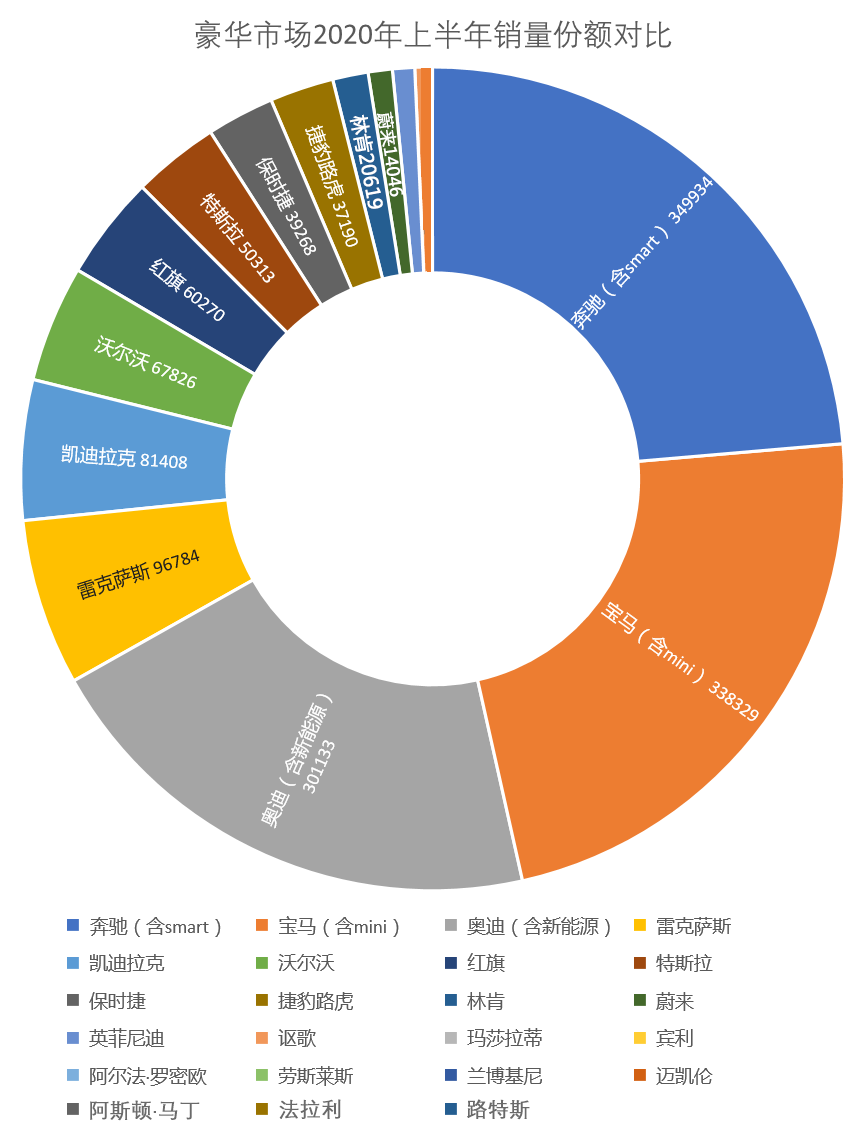
Affected by the weak car market and the epidemic, the decline in sales of luxury brands in the first half of the year is also reasonable, but the decline of different brands is still different. Cadillac fell 33.68% in the first half of the year compared with the same period last year, becoming the largest decline among the top 10 brands in sales. Jaguar Land Rover was followed by a decline of 27.85%.
Compared with the large fluctuations of second-tier luxury brands, the performance of the "top three luxury brands" in the first half of the year was relatively stable and outperformed the overall market of luxury brands. It is precisely because of the strong pull of Mercedes-Benz, BMW and Audi that the luxury car market as a whole is more prominent.
Although the year-on-year decline has become the mainstream performance of the luxury market segment, there is no shortage of uptrend brands like Lexus, which has become an "alternative" in the luxury market with a 4.83% year-on-year increase in the first half of the year. And the more special Tesla has also become an outstanding "latecomer" in the luxury market. Due to the successful implementation of its localization strategy, Tesla's sales growth reached 130.49% in the first half of the year. This achievement is not only excellent in the luxury market, but also in the mainstream overall market.
Of course, Tesla was not the only "catfish" in the luxury market in the first half of the year. Red Flag, an independent upstart, and "No.1 Brother", a new force in car building, sold 60270 and 14046 cars respectively in the first half of the year, up 101.44% and 83.58% respectively over the same period last year. Although there is still some "luxury deficiency" in terms of brand strength, with its differentiated positioning and commendable sales base, The two brands are still typical of the luxury market in the first half of the year.
The first line is stable, the second line changes.
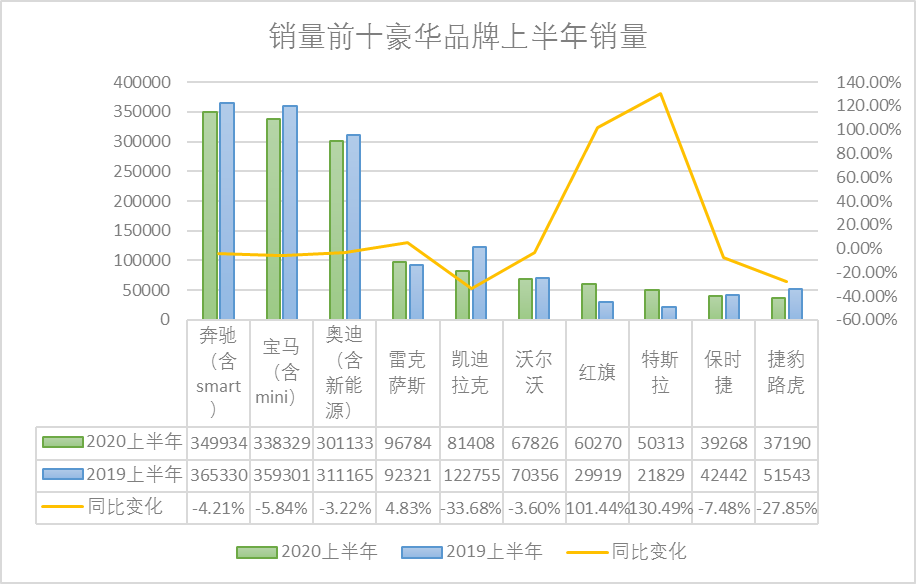
1. Front-line luxury: the competition of "Tian Ji Horse Race" is still going on.
Mercedes-Benz
Like BMW and Audi, Mercedes-Benz still sees China as its most important market in the world, and that position will not change for at least a few years. And according to Daimler's official sales figures, Mercedes-Benz sales in the Asia-Pacific region rose 8.9 per cent to 259404 vehicles in the second quarter from a year earlier, a record high for the same period, which officials said was mainly due to Mercedes-Benz's good performance in the Chinese market.
Coupled with the previously established "product offensive", Mercedes-Benz will introduce more than 18 new models in China in 2020; in terms of channel upgrading, Mercedes-Benz has vigorously promoted the "2020 Network upgrade Plan". With a view to creating closer customer relationships through service upgrades. Whether in the product or channel construction measures, the overall performance of Mercedes-Benz has been greatly improved.
BMW
Although BMW's sales fell the highest among the top three luxury companies in the first half of the year, its overall market performance is still commendable. Especially in the post-epidemic period, BMW launched a series of thematic brand communication events in April, including sales, after-sales, financial services and marketing; similar to the channel upgrade of Mercedes-Benz, BMW also tried the digital transformation and launched the "BMW remote Digital Marketing Assistant" to the first 69 dealers in less than a month at the beginning of the epidemic. Marketing tools and digital service experience have invisibly become the driving force behind the improvement of the ability of its sales system.
In addition, in terms of products, the BMW 5-Series plug-in hybrid became the "bright spot" in the first half of the year; at the same time, we can see that BMW has significantly increased the speed of new energy, including substantial progress in the landing of the beam car project. A number of BMW brand pure electric products have also been put on the agenda. Recently, brilliance BMW has once again expanded its production capacity for new projects in Dadong and Tiexi, with an annual production capacity of 1.4 million vehicles (84 per cent) is enough to show how big BMW's "appetite" is in China.
"Audi"
The sales gap between Audi and Mercedes-Benz reached nearly 50, 000 vehicles in the first half, compared with Audi's full-year target of 700000 vehicles in China, with a sales completion rate of 43% in the first half. Although the car market was hit by the epidemic in the first half of the year, Audi's performance in recent months should not be a big problem in achieving this goal.
However, some voices expressed concern about Audi's current "price for volume" strategy, and the huge terminal discounts gave a significant boost to sales of models such as the A6L. The author believes that this market strategy of Audi is closely related to the recent development situation. compared with the multi-brand strategy of BMW and Mercedes-Benz in China, Audi relies only on a single brand of FAW-Volkswagen Audi to engage in hand-to-hand combat with its competitors. sales are also limited to a certain extent. However, the good news is that Audi has continued to accelerate the introduction of models recently, and it has also paid more attention to new energy products. Most importantly, the cooperation between SAIC and Audi has taken shape. It is said that the SAIC Audi plant has been renovated, and the listing of Shanghai-made Audi is just around the corner. Seeing the gap between Mercedes-Benz and Audi gradually solidifying, Audi's expectation of relying on cooperation with SAIC to "turn around" has become more and more urgent.
At present, the "top three of luxury" is still an unshakable existence of first-tier luxury brands, especially the gap in sales level, which makes it extremely difficult to break down barriers between first-tier and second-tier luxury. And the competition between the "luxury top three" is also rising and falling, the position of the crown is almost "taking turns", the long-distance competition between the "top three" has never stopped, and the pace of competition like "Tianji horse racing" also makes viewers talk about it.
2. Second-line luxury: I only hear the laughter of the newcomers.
Lexus
Throughout the second-tier luxury camp, Lexus "iron fight" position has been unshakeable, steady performance as its brand connotation in general, without the shadow of a sword has been a decisive victory over the enemy. In the first half of the year, although affected by the epidemic in Japan, Lexus brands reported several times that their production capacity was limited and their sales were afraid to decline, but in terms of actual performance, Lexus's sales in China were not adversely affected. Instead, it achieved a commendable year-on-year growth.
As Lexus is a typical "fixed production by sales" brand, the supply is tight in the later stage of the epidemic, which makes consumers who are used to waiting feel "normal", and even the further tension in the relationship between supply and demand, so that consumers are more interested in Lexus brands. However, good products and services are a prerequisite for creating a unique relationship between supply and demand. The three "blockbuster products" of ES, NX and RX, coupled with the "hard to find" LM, make Lexus full of strength; with the introduction of UX300e new energy models, it is a foregone conclusion that Lexus sales will stabilize in 2020.
Cadillac
Compared with Lexus's "steady" performance in second-tier luxury brands, Cadillac is slightly hesitant in the past six months.
What on earth caused Cadillac's 33.68% year-on-year decline in sales in the first half of the year? After the early product sequence reorganization, Cadillac has sorted out the CT and XT series, the whole staff is assembled, and there is no deficiency in the product type spectrum; on the other hand, Cadillac takes Super Cruise and other science and technology as bonus points, and new technologies have been applied to existing models one after another, and there is no deficiency in technology.
But the driving force behind the 30% decline does exist, and it is a difficult problem for Cadillac. First, the side effects of the early "price for volume" appear, the market is low, consumer confidence is insufficient, and potential customers intensify the wait-and-see mentality; second, GM has entered a trough in China, and none of its brands Buick, Chevrolet, and Cadillac have been spared. It will still take time to get out of the trough, and the impact will continue. It will take time for Cadillac to wrestle with Lexus again.
Volvo
Volvo didn't get into the limelight many times in the first half of the year, but it kept its sales scale, second only to Audi in its 3.6% year-on-year decline. In today's market conditions, a small decline actually means surpassing the competitors. Most crucially, Volvo tends to be close to the second-tier luxury first camp because of the sharp decline in Cadillac. In addition to the special Tesla who followed, Jaguar Land Rover and Lincoln have been left behind by Volvo.
From the point of view of terminal sales, a large part of Volvo's sales support comes from its attractive "discount range", and the reason for adopting this strategy is closely related to Volvo's localization ratio. With the improvement of the localization ratio, the price advantage of Volvo models is becoming more and more obvious.
Trail Tesla
It is controversial to include Tesla in the luxury brand camp. After all, its product category is different from that of traditional fuel vehicles. However, in terms of brand positioning and portraits of consumer groups, Tesla has become an out-and-out luxury brand.
Needless to say, the market capitalization of Tesla brand has exceeded the sum of a group of "big brother manufacturers". Today's Tesla is like a balloon inflated rapidly, expanding at such an astonishing speed. And it has realized the real "corner overtaking" with the help of the technical advantages of pure electric vehicles.
In the first half of the year, Tesla disrupted China's luxury medium-sized car and pure electric car market with a home-made Model 3 alone. With the acceleration of the localization of new models in the second half of the year, the "butterfly effect" caused by the surge in sales of Intezra is still to be expected. after all, everyone loves the story of "the sudden rise of the Forces nouvelles".
Porsche
According to the official news released by Porsche, China was still Porsche's largest single market in the world in the first half of 2020; and as the epidemic in China gradually stabilized, the delivery of new Porsche cars in China began to increase in March, and the new order volume in June reached an all-time high, in which Macan, Cayenne and Panamera models played a major supporting role in Porsche sales.
The great vitality of China's luxury brand market in recent years and the unique charm of Porsche brand to Chinese consumers make its development potential in the Chinese market far from reaching the bottleneck.
Lincoln
As an American luxury, Lincoln's development path in China seems to be slightly different from that of Cadillac. From the beginning to the present, Lincoln gave the outside world the impression of "high-end" but not "follower", and the demand for sales did not seem to be the current goal of the brand.
After gradually gaining a firm position in the luxury market, Lincoln's pace of localization began. Domestic adventurers sold more than 3000 cars in June, setting a new record for Lincoln's highest monthly bike sales in China. The great success of the adventurer was the first "great victory" after Lincoln's localization. On July 8, Lincoln's domestic pilots went public with a price starting at 509800 yuan. With the landing of the second domestic model, Lincoln has upward localization product support.
However, Lincoln, who has seen the dawn of hope, is also faced with the tradeoff between "gain and loss". It is rumored that Lincoln will stop producing mainland models after 2020 and become a luxury brand focused on SUV models. If you gamble into the SUV field, Lincoln will have more significant product features, but may also be destined to take a more subdivided path.
Jaguar Land Rover
According to the data released by the manufacturer, Jaguar Land Rover achieved four consecutive months of year-on-year growth in the first half of the year, but the manufacturer did not mention a specific sales figure. According to the listed data, Jaguar Land Rover registered a total of 37190 vehicles in the first half of the year, down 27.85% from a year earlier, second only to Cadillac.
Although it is necessary to have models and production capacity, Jaguar Land Rover's sales are hardly improving. In my opinion, Jaguar Land Rover still lacks "main models" that can stir up sales, coupled with the teasing of the market about the terminal price of Jaguar Land Rover, so that the brand is "looked down on" a lot. With the return of the discontinued Land Rover Guards in the second half of the year, Jaguar Land Rover will also get a limited boost to growth. How to make full use of the air advantage created by its top products (such as Land Rover) in the luxury market segment to fully activate the market and regain the widespread recognition of its luxury brand image by the public has become its biggest challenge.
3. Other luxury brands
Infiniti and Acura
The reason why the two brands are put together is that there are too many similarities between the two. Infiniti and Acura, once among the mainstream luxury brands, sold only 12866 and 5319 vehicles in the first half of 2020, down 36.63 per cent and 27.81 per cent respectively from a year earlier. I can't help but feel sad.
Once the "top three of Japanese luxury", Lexus is now the only one left. Shrinking sales and occasional gossip in the first half of the year have cast a shadow over Infiniti's future in China. Similar to Infiniti's development in China, Honda's high-end brand Acura dominates the North American market, but it is difficult to convince the soil and water in China. Brand awareness, product lines and other issues have become obstacles to the development of Acura.
Red flag
Red Flag, as a brand with its own "red" attribute from birth, has been like misty clouds and smoke for many years, but when it was decided that "it has now flown into the homes of ordinary people", the landing of the Red Flag was decisive and thorough.
Among the best-selling models, H5 and HS5 have become the main models at present, H7 and HS7 have given Hongqi a solid support, while H9 has made Hongqi qualified to eventually climb the "round table of luxury brands". When the upward strength becomes stronger, the red flag also shows a strong stamina.
Although total sales in the first half of the year reached 60270, an increase of 101.44% over the same period last year, it is still difficult to argue that today's red flag will be included in the luxury market category. The controversy over whether Red Flag is a high-end brand is mainly focused on the H5 and HS5 models, whose terminal prices range from 150000 yuan to 250000 yuan, which is still far from the average price of 300000 yuan for luxury brands in the industry. Although the prices of H7 and HS7 are enough to make the shortlist, sales have not been successful. From the author's point of view, what Red Flag needs most is time, as long as it is given enough time for high-end models to fully release sales, I believe that Red Flag can maintain the current sales growth, and even its annual results are likely to create the highest year-on-year growth in the industry.
Come to Wei Wei
The Vulai car, which has been labeled with various labels, has finally straightened up. A total of 14046 vehicles sold in the first half of the year, making it a well-deserved "number one" of the new car-building force. Although the early ES8 encountered many difficulties in opening up the market, after two or three years of cultivation, consumers' recognition of the Weilai brand has been greatly improved, and the follow-up product ES6 has also inherited the "baton" of price decline.
Now it seems that continuing to expand the scale is the biggest problem that Weilai needs to face. with the unique marketing strategy of "done by enterprises and users together", Lailai needs to continue to rely on users to open up new markets and continue to promote the listing of new products. Fortunately, EC6 is listed in the middle of the year, which makes another "playable card" in the second half of the year, and naturally one more layer of strength to gain a foothold in the luxury brand camp.
If you get the "three segments", you will get the luxury market.
For different segments of the luxury brand market, the "top three luxury" show due strength and advantages. Especially in the field of medium-sized cars, medium-sized cars and medium-sized SUV, Mercedes-Benz, BMW and Audi leave almost no chance for other competitors to fight back. Even so, other luxury brands have won a crucial share of the segment, relying on some of the advantages of their "fist models".
1. Car
Medium-sized sedan
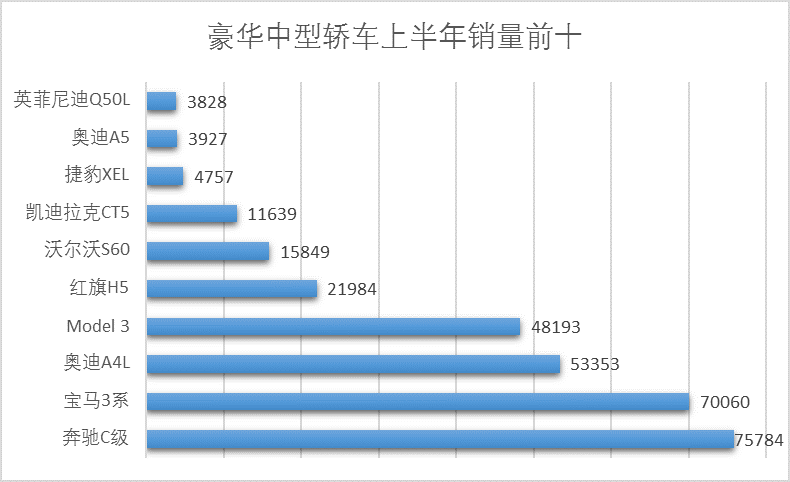
As the most traditional and basic segment of the luxury brand market, medium-sized cars have been the foundation of the "top three luxury" for many years. However, from the perspective of sales in the first half of the year, the sales of Audi A4L has been significantly widened by the BMW 3-Series, while the hot sales of Tesla's Model 3 enabled it to get a precious "boat ticket" to be included in the luxury brand sales list. Volvo S60, Cadillac CT5 sales ranked the second ladder of the model level; Red Flag H5 due to the price of outstanding sales, but not comparable. The third camp of Jaguar XEL, Audi A5, Infiniti Q50L and the first and second camp formed an order of magnitude gap.
Tanzhong large sedan
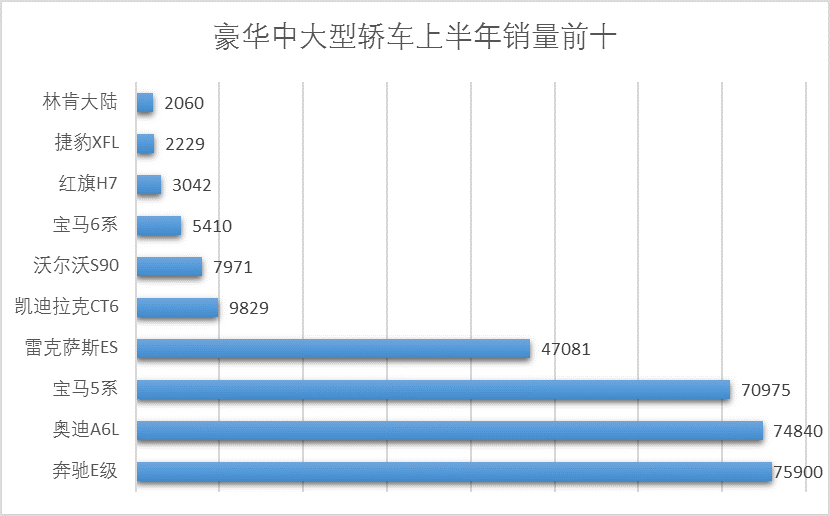
Medium and large cars also show a three-step distribution. Mercedes-Benz E-Class, Audi A6L and BMW 5-Series occupy the top three seats, with sales of more than 70,000 vehicles in half a year. In the second ladder, only Lexus ES sold more than 10, 000 vehicles and less than 50, 000 vehicles in half a year. According to this trend, if manufacturers increase the supply of ES, their sales still have a lot of room to rise, and there will be a "top four" situation in this level of market segment in the future. In the third ladder, Cadillac CT6, Volvo S90 and BMW 6-Series all sold more than 5000 vehicles but less than 10, 000 vehicles in half a year. Compared with the achievements of Lincoln Continent, Jaguar XFL and Red Flag H7, the polarization in the field of medium and large cars is more prominent, and this trend is likely to intensify in the second half of the year.
The flagship sedan
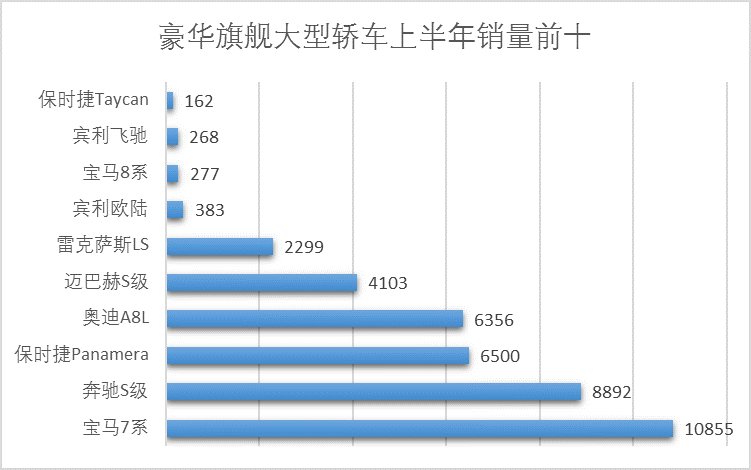
In terms of luxury flagship large cars, only the BMW 7-Series sold more than 10,000 cars in half a year. Among other models, the Porsche Panamera unexpectedly overtook the Audi A8L to rank third, while the decline in the A8L is also very iconic, indicating that people's impression of traditional high-end cars is beginning to change, and the tendency of diversified choices, such as Maybach S-Class and Lexus LS, has also become more obvious.
2 、 SUV
Compact SUV
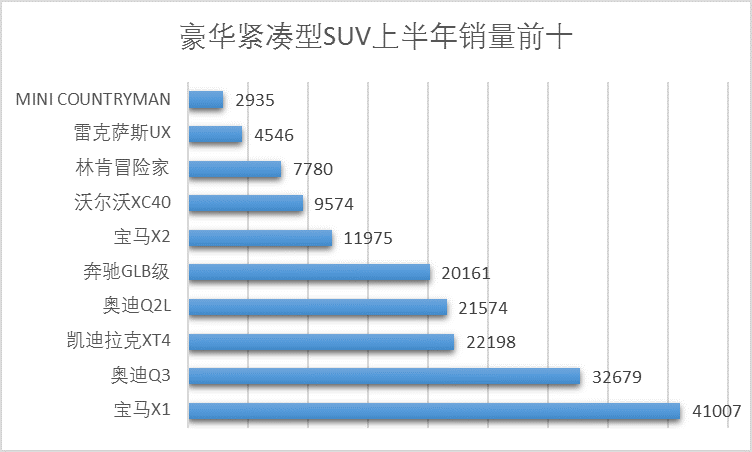
In the field of compact SUV, BMW still has the advantage, with the X1 gaining an advantage of 41007 vehicles in half a year. Although Q3 ranked second, Q2L of the same brand obviously made up for consumers' aesthetic fatigue of Q3 and retained this part of the market share. BMW, which also has dual models, although the X2 sold more than 10,000 vehicles in the first half of the year, there is a more obvious gap between X2 and X1, and the product structure is slightly unbalanced, so X2 is in danger of being marginalized. From a brand point of view, GLB in Mercedes-Benz brand plus, there is still the possibility of sales increase, but compared with the cost-effective Cadillac XT4, GLB still lacks some sincerity to fight for more share.
"medium-sized SUV
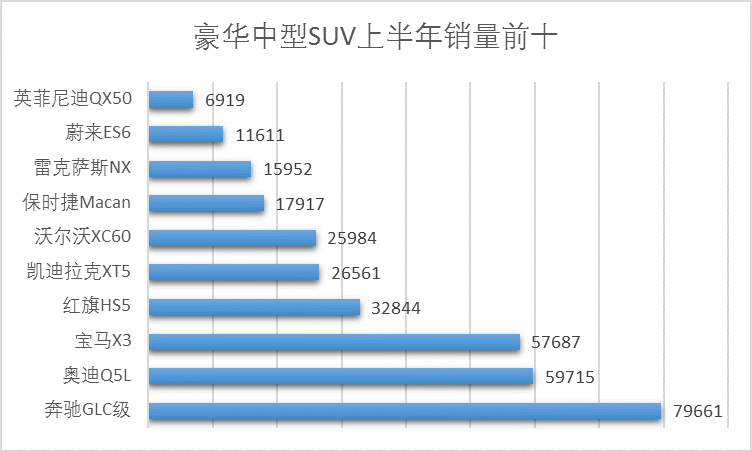
In the medium-sized SUV sector, Mercedes-Benz GLCs take the lead, selling nearly 80, 000 vehicles in half a year, far surpassing Audi Q5L and BMW X3. Like the Mercedes-Benz E-Class, the GLC has become the mainstay of Mercedes-Benz sales. Compared with the GLC, the Audi Q5L and the BMW X3 are relatively at the same level, and the two models are neck and neck in this "magnitude". Since GLC went on sale in 2015, when the product was in the middle of its life, sales were most effective, while the latest Audi Q5L and BMW X3 were both launched in 2018 and are still in the stage of product growth, so sales are completely released. As a result, sales of Q5L and X3 are expected to increase gradually within two years until they surpass GLC, which is in the late life of the product.
The distribution of sales in the medium-sized SUV is relatively balanced, which also reflects the fierce competition in this segment. The competition for strength among brands will continue in the second half of the year, from 32844 of Red Flag HS5 to 11611 of Xilai ES6.
Medium and large SUV
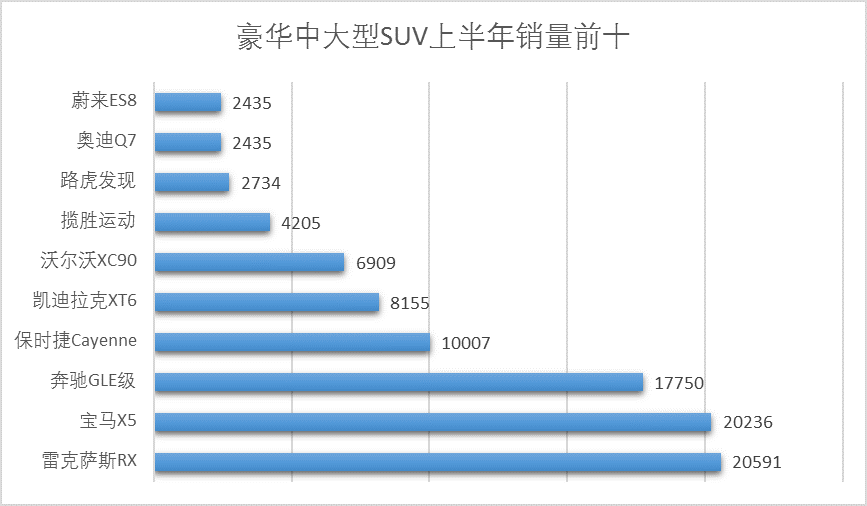
Lexus RX topped the list, fully demonstrating the accuracy of manufacturers' investment in market segments. On the basis of already strong competitiveness, Lexus launched RX L in 2019 to further increase the competitiveness of products, and the effect is also very significant. Compared with the reasonable performance of the BMW X5 and Mercedes-Benz GLE, the performance of 10007 Porsche Cayenne in the first half of the year is also quite eye-catching, but because the average price of a bicycle is higher than that of similar products, it shows the strength of Porsche Cayenne.
Full size SUV
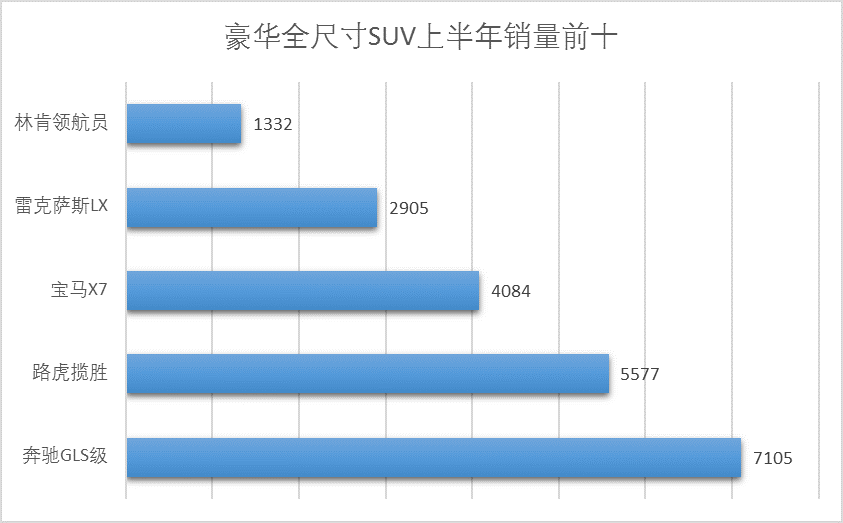
As luxury brands have fewer full-size SUV models, they only make statistics on the top five. In this field, the advantages of Mercedes-Benz GLS and range Rover are very obvious. Although BMW X7 entered the domestic market in 2019, the momentum is very strong, and it is expected that there is still room for sales to rise in the second half of the year.
3. New energy vehicles
The new energy market has gradually evolved from "showing muscle" to "seizing the future market". The frequent actions of luxury brands on new energy models and technology reserves in the past two years are enough to show that the major luxury brands have therefore begun to go deep into the hinterland of the new energy market. However, the pace of each manufacturer is slightly different, such as BMW's early start in all-electric models, followed by Audi and Mercedes-Benz. In addition, in the layout of plug-in hybrid models, Volvo invested more in second-tier brands, while Cadillac simply did nothing. Lexus finally released pure electric models in the first half of the year on the premise of making full use of its hybrid models. Compared with traditional power models, the major luxury brands pay more attention to the new energy market segment, and the rhythm is also more tense.
Pure electric vehicle
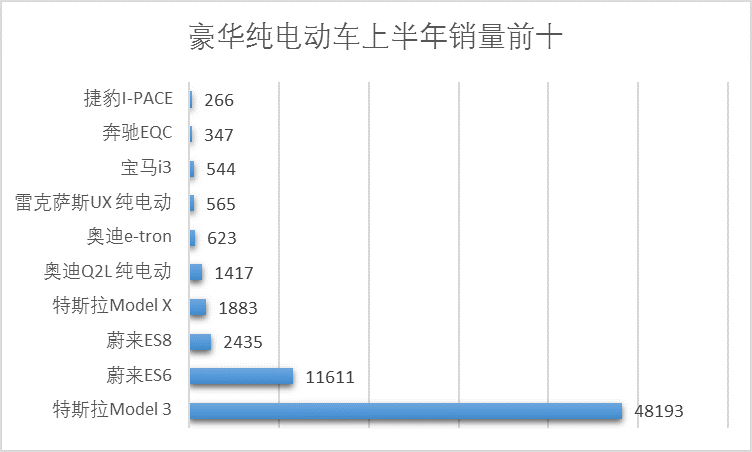
Since its domestic listing at the end of November last year, the localization of Model 3 has had an immediate effect, and the price of less than 300000 yuan has torn open an entrance to China's electric car market.
How strong is Model 3? Half-year sales can be seen, the sales of Model 3 alone exceed the sum of the 2nd to 10th places of luxury brand pure electric models, and even other domestic independent brands' pure electric models are much worse than Model 3.
Among them, the June sales of Model 3 have exceeded 15000, even reaching the same level as Mercedes-Benz C-Class and BMW 3-Series. The key is that there is still some room for improvement in the proportion of local procurement of Model 3 parts, and a price drop will become inevitable. From this point of view, Model 3 not only stirs up the new energy vehicle market, but also brings severe challenges to traditional luxury brands.
Beyond the glow of Model 3, there is also ES6 worth talking about. Since its high-profile listing in January 2019, ES6 has gradually replaced the main position of "brother Tongmen" ES8. In 2020, ES6 deserved to stand in the "C position" in the new power camp of car building, and the reputation of "user enterprise" established in the past few years will also play an important role for it to continue to gain a larger rising space.
In addition, Audi Q2L electric version, Audi e-tron, Mercedes-Benz EQC, and Lexus UX electric version, which launched in 2019, all began to show competitiveness in the first half of this year, while BMW i3, which was the first to occupy the luxury pure electric market, was squeezed into eighth place.
In the first half of the year, pure electric models of luxury brands worth 200000 to 300000 yuan are still the main "walking volume" products. In addition to Tesla's Model 3, Audi Q2L pure electric version, Mercedes-Benz EQA (expected to be listed in 2020), Lexus UX pure electric version and other later listed models are all "seed players", while the competitive trend of luxury pure electric subdivision is likely to determine the competitive pattern of the basic sales of luxury brands in the future.
Plug-in hybrid car
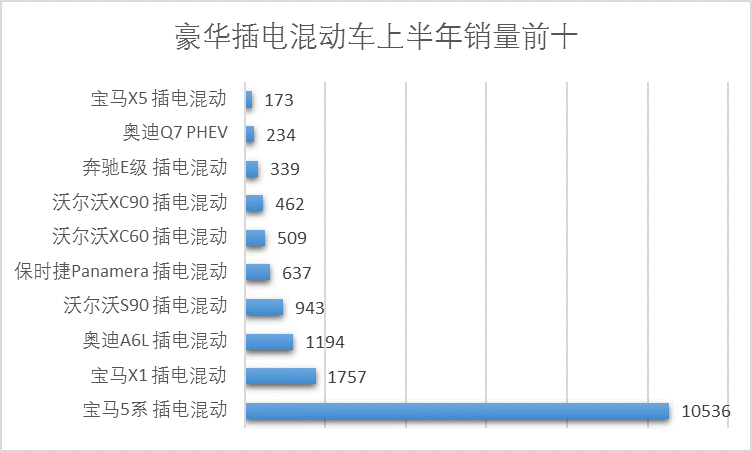
The plug-in hybrid field basically restores the product technical capability of the established luxury brand. After the localization of the BMW 5-Series plug-in hybrid version, it has gained a great price advantage, and fully demonstrated this advantage in sales. The performance of 10536 vehicles in the first half of the year makes it enough to jump out of the original order of magnitude with other competing models.
Unlike BMW and Audi's expectations on plug-in hybrid products, Volvo has invested more in plug-in hybrid models than other second-tier luxury brands, and its four models have launched corresponding plug-in hybrid versions. it provides consumers with a wealth of choices.
How far is the fourth consumption era?
The performance of the domestic luxury market was relatively excellent in the first half of the year, and the market share of the luxury market continued to increase even though it was affected by the epidemic. The reason for this market situation is not only related to the maturity of the domestic car market, but also related to the market penetration of luxury brands. However, there has been an inflection point in the domestic car market since 2018 and encountered an epidemic in the first half of 2020, and the decline in the market is even more drastic. The increase in the market share of luxury brands may be one of the phenomena of the adjustment of China's car market, or it may be a short-term response to the overall transformation of the car market.
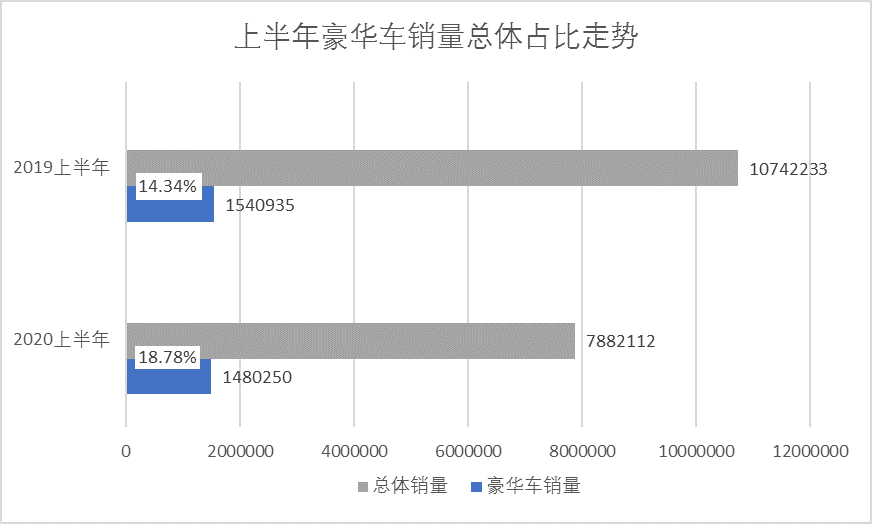
According to the book "the fourth consumption era" by Miura Exhibition, since 1912, consumption has been divided into four stages: the first consumption era is the consumption enjoyed by a small number of middle class; the second consumption era, taking advantage of the spring breeze of rapid economic development, family-centered consumption is strong; in the third era, the personalized trend of consumption has sprung up. Today, Japan has entered the fourth era of consumption, that is, a society that attaches importance to "sharing". Judging from the development of Japan, many people have concluded that domestic consumer demand has begun to enter the end of the third consumer era, so it can be predicted that the growth of luxury brands in China's car market does not have unlimited potential, but how high the ceiling of the luxury brand market is, at least so far. And when the door of the fourth consumer era begins, the luxury brand market will also enter a stable period of maturity, and the market pattern will be reconstructed as a result.
Click to understand and sign up for the 2020 China Automotive New Materials Application Summit Forum.

Please fill in your personal information on the last page and the meeting staff will contact you later!
For queries, please contact Lemon Zhao at lemonzhao@smm.cn
For more information on how to access our research reports, please email service.en@smm.cn